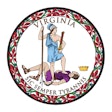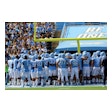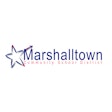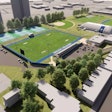A range of products have emerged to meet the many and diverse needs of older adult exercisers.
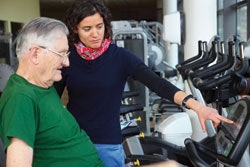 EASY CHAIRRecumbent cardio equipment with large graphic displays are especially accommodating to older exercisers.
EASY CHAIRRecumbent cardio equipment with large graphic displays are especially accommodating to older exercisers.Turn back the clock to October 2008 and two stories dominate the headlines: the faltering world economy and the U.S. Presidential election. So, the Oct. 7 release of the U.S. Department of Health and Human Services' comprehensive "Physical Activity Guides for Americans" may have been ill timed as a news event, but it was newsworthy nonetheless.
The federal department - based on an extensive report from a 13-member advisory panel charged with analyzing mountains of scientific research - for the first time unequivocally stated what many people in the fitness industry already suspected: that regular physical activity over the course of months and years produces long-term health benefits and reduces the incidence of chronic disease and early death. An exercise regimen that incorporates frequent cardiovascular fitness and strength training, the report states, reduces the risk of heart disease, stroke, high blood pressure, type 2 diabetes, colon and breast cancers and depression, among other maladies. For older adults, in particular, the guidelines state (also unequivocally) that regular exercise can "improve thinking ability" and "the ability to engage in activities needed for daily living."
"The federal government acknowledged that regular exercise will - not could or might, but will - help prevent a number of these chronic diseases," says Pete McCall, an exercise physiologist with the American Council on Exercise, stressing that the guidelines aren't just preaching to the choir. "As that message filters down to older adults who have more time as they slim down their work schedules, that becomes a key market for facility operators to pay attention to."
Throughout the descriptions of its guidelines, the Health Department repeatedly offers a caveat when discussing findings related to regular exercise participation in older adults. In short, they should only be as physically active as their abilities and chronic conditions will allow. Read between the lines, some fitness experts say, and you can see a huge opportunity for health club practitioners, as well as fitness equipment manufacturers, to fill a gap by providing equipment that caters specifically to the functional needs of older adults, encouraging and allowing those users with limited physical abilities to exercise more.
"If you look at the numbers and you see the potential that the manufacturers have sitting in front of them, it is as if some of them have turned a blind eye to the older-adult market," says Colin Milner, founder and chief executive officer of the International Council on Active Aging. "More than 50 percent of the CEOs in the United States have absolutely no plan in place for dealing with Baby Boomers or their parents. That's irrespective of the fitness and wellness industries. You would think, considering the numbers, that people would be clamoring to get on this bandwagon, but aging is not sexy. It never will be."
The good news is that not all manufacturers have turned a blind eye to older adults, and they're backing up their marketing efforts with products that truly are designed to help those exercisers reach their fitness or rehabilitation goals. "A lot of these products are built based on the questions, 'What are the health issues?' and 'What are the solutions to those issues?' " says Milner. "It could be joint mobility or dealing with heart disease. Those are the issues, and somebody should be trying to find a solution."
McCall, for one, believes that functional-training equipment is even more of a trend in facilities targeting older adults than it is in facilities serving a broader demographic, which may rely more on generic selectorized strength equipment or one-size-fits-all cardio machines. "Functional training is designed to enhance the activities found in your daily life," he says. "It is derived from athletic performance training. You're training to enhance certain skills - power, strength, speed or agility. To apply that to the older adult market, you just have to look at the needs of that population, whether it is balance, stability, mobility or strength."
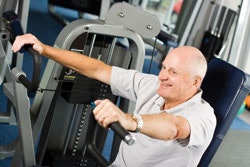 LIGHT WEIGHT CHAMPIONSExercisers with limited strength benefit from machines offering low starting resistances and smaller resistance increments.
LIGHT WEIGHT CHAMPIONSExercisers with limited strength benefit from machines offering low starting resistances and smaller resistance increments.To do that, adds Milner, equipment needs to be designed with accessibility in mind. Because older adults suffer from any number of conditions that can inhibit movements, the equipment serving that population should be as inclusive as possible. "Really what we're talking about - whether dealing with a specific disability, a younger person or an older person - are products that are going to be accessible to everybody."
Following are some major equipment categories in which purchasers of fitness equipment for older adults now have a greater selection than ever:
Balance: One glaring issue with many older adults is falls. According to a U.S. Surgeon General's report released last year by the U.S. Centers for Disease Control and Prevention, one in three Americans age 65 and older falls each year, and 50 percent of those people will fall again within a 12-month period. A vicious cycle can result - with fear of repeat falls leading to near-complete inactivity.
While balance and stability have emerged over the past decade as a major fitness category for exercisers at all levels, balance assessment tools have become more popular in fitness and rehabilitation centers serving older populations. Products range from simple ball- or board-based tools to complete balance testing and training stations with LCD screens, interactive training modules and screening devices, and advanced data tracking and storage capabilities. At least one manufacturer offers a balance station with a "locking surface" designed for patients with balance issues to easily and safely mount and dismount.
"There is a plethora of balance-based equipment," says McCall, noting that balance training for older adults epitomizes functional training, as balance - maintaining a center of mass over a base of support - is so critical to many people's daily activities. "Can you balance on your two feet first? Once you do that, then you can go to a one-foot position. The majority of the gait cycle when walking is on one foot. So, if you want to really mimic how an older adult moves, you want to look at the movements they regularly perform and then break those movements down into patterns."
Resistance/Strength: The widespread proliferation of resistance equipment has been a boon to fitness providers serving the older-adult market. Equipment exists to provide low-impact and low-starting-resistance utilizing gravity, water, air and hydraulics, cables and bands. Even manufacturers of traditional weight stacks have designed their units to be more accommodating to a variety of users by offering lower starting resistances and smaller resistance increments. For their part, free-weight manufacturers have introduced improved grip technologies.
McCall points to the fact that much of this equipment has been developed to be more accommodating than a lot of traditional weight-training equipment in that it is ground-based, allowing easy access for users with limited movement. "The big trend is for this more functional, ground-based training equipment," McCall says. "The users can train on their feet using ground reaction and gravity as the prime drivers creating force."
Despite a wide range of resistance equipment options for people with limited mobility and strength, Milner says they are not necessarily specific to the older-adult market. "The elite and the fit users are, for the most part, using a lot of the same equipment that everybody else is using," he says. "However, consider the number-one product among older members - bands. Forty-six percent of the population can't lift 10 pounds by the time they're 80, so they use bands. But the band hasn't really changed a lot over the years. The question is, 'How will some of these tools that are used all the time be modified to address specific issues like arthritis?' It's issue-solution. Some people have asked those kinds of questions, but not to any major degree."
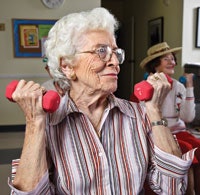 NATURAL CURLSImproved grip technologies help older adults maintain their hold on even the lightest free weights.
NATURAL CURLSImproved grip technologies help older adults maintain their hold on even the lightest free weights.Cardiovascular: Advances in the design of cardiovascular equipment have benefited older users, in particular. For starters, numerous manufacturers make recumbent models of bikes, elliptical trainers and step machines. "The issue there is stability," says Milner. "If I am not able to stand upright solidly, I'm not going to be able to utilize a traditional treadmill." But manufacturers have realized that even getting into the seat of a recumbent machine can be a struggle for many people with limited movements. Some have created "walk-through" models, which leave enough space for a person to easily pass between the saddle and the pedals and/or control panel, while others have introduced models with saddles that swivel sideways for easy entry.
An entire segment of what would traditionally be labeled cardio equipment has been developed for rehabilitation applications. At least one manufacturer offers a recumbent machine featuring unilateral upper-body movement, meaning only one arm is required, making it a good option for stroke victims and others with physical limitations. Yet another manufacturer offers a split-belt treadmill, in which two independently controlled belts can run side-by-side at different speeds, again benefitting people with neuromuscular problems.
Total Body: Though not exclusive to older adults, vibration machines, therapeutic spas and other total-body units that offer users a no- or low-impact experience while promoting circulation, muscle relaxation, mobility and other benefits seem particularly well-suited to the older-adult population. "There is a product out there that is like a whole-body vibration therapy - although it is referred to as 'whole-body periodic acceleration' - where the user is essentially in a bed-like setting," says Milner. "Will that become an equipment category of its own? I have no idea. But for years we've been talking about a gentler form of exercise. People have not bought into the 'go out there and pound yourself into submission' message."
Cognitive Function: Although the collective scientific analysis of the concept of "brain fitness" - which contends that regular mental exercise leads to better long-term mental health - can be inconclusive, numerous manufacturers are embracing the concept by integrating physical fitness machines with mental exercise components. "Some older-adult and dementia researchers are realizing that cognitive function activities such as crossword puzzles, Sudoku or regular reading can have a positive impact on maintaining neurons," says McCall. "The thinking is, if you don't use your brain on a regular basis, like any muscle, it will atrophy."
To that end, makers of brain fitness programs have teamed up with makers of exercise equipment to embrace the mind-body connection. One recumbent bike product, for example, offers users 22 mental exercises - such as memory of names and faces, arithmetic and visual-spatial skills - designed to stimulate different parts of the brain. Users navigate the exercises with a wireless mouse, pedaling all the while. "When you look at the research, it shows that a huge issue on most older adults' minds is losing their cognitive abilities, right behind losing their independence and health," says Milner. "Those do go hand in hand."
McCall cautions facility operators to remember that equipment selection is only one aspect of attracting older adult populations. "They want the equipment to feel comfortable," he says. "But just as important, they want to feel comfortable in the overall environment. Is the facility clean? Is the equipment in good condition? Are there people to answer questions? Is the music appropriate?"
All of those types of questions, agrees Milner, are important in assessing whether a fitness center is accommodating to older users. "Over the years, the 65-and-up market has been fairly flat - as have the rest of them, by the way," Milner contends. "I would argue that part of the reason it's flat is because we haven't presented fitness and fitness equipment in a manner that resonates with enough of this audience."


















